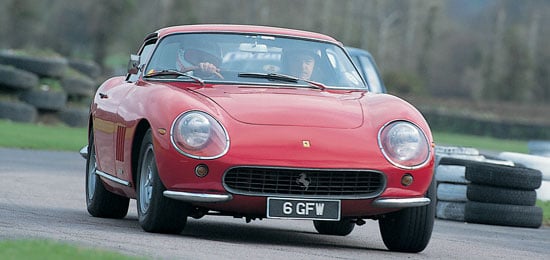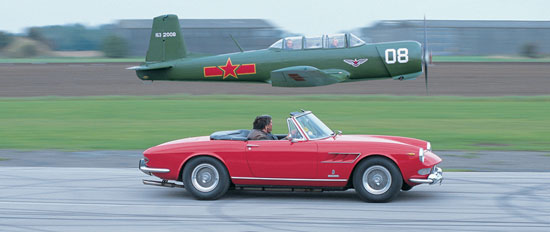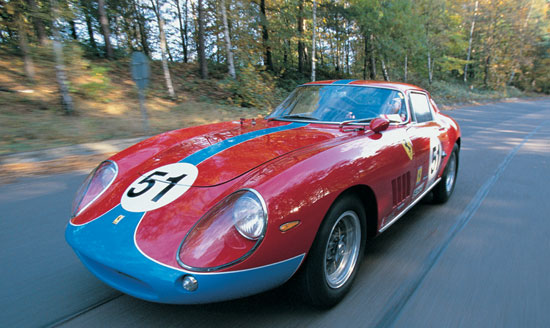
The following is an extract from a 16-page supplement on the Ferrari 275 in October's Auto Italia magazine. For access to the full feature, plus articles on driving the Ferrari 575GTC, the 2004 Le Mans Classic, the De Tomaso Deauville, Lancia Fulvia S05 and much more, see www.auto-italia.co.uk
Ferrari 275 GTB
Enzo Ferrari’s last Berlinetta before the Fiat takeover was a tough act to follow. Geoff Williams has owned this 1965 short nose two-cam 275 GTB for eight years and uses it for everything from shopping to track days. . It was at one such trackday at the Goodwood Motor Circuit when he handed me the keys. Although not 100% original, the few modifications carried out are in keeping. Most noticeable are the four-cam wheels that are stronger than the original two-cam rims. Yokohama 205/70/14 tyres replace the Michelins. The propshaft has been updated from the single u/j type to the twin u/j type. Modified springs are also fitted and all the original components are in Geoff Williams' garage. A recent engine rebuild has been carried out with torque as a priority. Power is rated at 280bhp at 7500rpm.
Once inside the low-roofed machine you notice the simple but elegant interior; classic instruments, classic woodrim and sporting trim and, typically of the period, less luxurious than you might expect. The space behind the seats is for baggage only. The motor fires up in a clamourous burst of Ferrari fussiness and mechanical thrash. It quickly settles down to a stable idle. The gearlever works well considering the five-speed gearbox is rear-mounted and first generation to the Prancing Horse. The ratios are well-chosen to keep the car on cam. From a time when you could hear the 12 butterflies breathing, you know exactly how the car with the horse badge is feeling. The torquey motor pulls strongly from 2000rpm. It will rev round to 7500rpm but there is little point in taking it beyond 6500rpm – better to let the torque do its job than buzz the motor.
On Goodwood’s fast corners the 275 porpoises with under-damping and wants to oversteer. The front end would benefit from a bigger anti-roll bar or stiffer springs. The front/rear stiffness ratio, the spring rates and the dampers need a re-think. No big deal but as with any car used on a track, it’s all about sorting the suspension. The ATE brakes which replace the original Dunlop brakes are adequate with gentle circuit use, but without certain tweaks, they would still burn and melt in race conditions.
Weighing 1240kg, the 275 GTB has a 50/50 weight distribution and double wishbone suspension all round. This means that once ‘sorted’ it can be enjoyed like no other configuration. A correctly set up 275 GTB should have neutral handling with fine tuning available from the throttle pedal. The 275 GTB is a good all-rounder, whether a shiny concours car, an everyday hack like Geoff’s or a competition-prepared car for historic events, the 275 GTB can fulfil many roles.

Ferrari 275 GTS
I’ll start with an apology. There was a huge distraction on the test drive of the 275 GTS. Normally being given one of the world’s most beautiful classic open two-seater sportscars to play with would concentrate the mind. Sorry also to Andrew Cooper who loaned me the beautiful Ferrari that he has owned and cherished since 1976.
We were oop north in Yorkshire at The Real Aeroplane Museum at Breighton Airfield. It’s the fault of Auto Italia magazine’s Editor really as he thought it would be a good idea to carry out a twin-test with two vehicles of similar value, similar weight and similar power, so we pitched the Ferrari 275 GTS against a Chinese war plane. When I told the test pilot Brian Brown that it had always been my ambition to crash a plane, I was relegated to the back seat and aerobatics. However, I can report that the sharp Pininfarina lines of the 275 GTS look just as good from the air as they do from the ground.
Technically similar to the 275 GTB, the SOHC per bank V12-engined GTS was detuned 20bhp to 260bhp at 7000rpm. Detuned might be the wrong word because the GTS is more user-friendly having more torque at lower speeds. The gracious lines of the GTS combined with its V12 charisma combine to create supreme elegance. With a 0-60mph time of just under seven seconds, a 0-100mph time of 19 seconds and a top speed of 145mph, the Ferrari is almost a match for the period yardstick, the Jaguar E-Type.
As with the GTB with which it shares so many mechanical components, the five-speed metal-gated lever is slow in operation. But this is a grown-up’s car and performance figures are not what the GTS is about. Despite the pace available, this is a Ferrari you would enjoy without having to prove yourself by hurtling about at great speed. Very much gentleman’s sportscar, it has plenty of elbow room and a tastefully understated presence. It handles nicely and communicates well with the driver. If you do give it some stick it rewards the driver well. Push too hard and the breakaway happens slowly. With 1260kg about to go lateral, there is plenty of warning through the steering wheel as well as audible notice of intention from the tyres. The hood operation is simplicity itself, complementing its comfort and practical touring qualities.

Ferrari 275 GTB/C
You can tell when they come in from the States because they make a lot of noise and they don’t like corners. The USA may have Silicon Valley but the UK has Motorsport Valley with grass-roots experts in countless sheds as well as contributing nearly £5 billion p/a to the UK economy.
Where the UK noise police insist on over-silencing, the Americans installed megaphone exhausts to make it louder. At full chat the howl from the 3.3-litre race-tuned engine is awesome. At 300bhp maximum power is only slightly up on a standard 275 GTB. Power delivery on the 275 GTB/C is much improved but with a top-end bias. From 4000-7000rpm the ‘C’ for competition version is markedly stronger.
Interior trim is minimal. Access to the short bucket seats is easy as there is only a rear roll hoop. Typically Ferrari, the interior is functional while retaining a few ergonomic nightmares in order to maintain the Maranello magic. Instrumentation is good, but switch labelling could be better, that sort thing. Brake and clutch pedals are adjustable and there is a left footrest.
The gearlever is metal-gated with first on a dogleg – left and back. At first you have to look at the gate every time you change gear but after a while you get used to it. With a power to weight ratio of 316bhp-per-tonne, 0-60mph is in the order of five seconds and 100mph in 12 seconds. Top speed would be in the region of 150mph – 180mph depending on gearing. ‘Historic’ grip with these modern-day performance figures means thinking ahead. The brake pedal remains firm while clamping the four solid discs. Cornering could be better because the rear end is far too stiff. Oversteer and rear-wheel lifting are a problem.
With little rear suspension travel and a full three turns lock-to-lock much arm-twiddling is needed to catch the Ferrari as the rear end steps out. The photographers are happy. The driver is happy, but the stop-watch is not. You can feel the 275 trip over itself as the rear wheel lifts. That apart, everything else is superb. The competition GTB feels light. It is such a different animal from a standard car. Weight of the GTB/C is down from the 1240kg of a steel 275 GTB, to only 990kg. You can feel everything through the chassis and steering wheel. It would be a shame to see such a piece of Ferrari history punching a hole in the scenery just because it requires a routine handling set-up. Don’t they have corners in America?
|
Words by Roberto Giordanelli and Pictures courtesy of Peter Collins, Phil Ward and Auto Italia magazine.
See www.auto-italia.co.uk or call 01858 438817 for back issues and subscriptions. |




